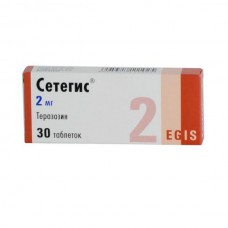Expiration date: 11/2026
Structure and Composition:
Tablets. One tablet contains terazosin (in the form of terazosin hydrochloride dihydrate) 1, 2, 5 or 10 mg
Other ingredients: magnesium stearate, talc, starch, povidone K30 gelatinized maize lactose monohydrate also contains ariavit quinoline yellow - Table. 2 mg ariavit Sunset Yellow - Table. 5 and 10 mg
in blister 10 pcs. In the paper cartons 3 blisters.
Description pharmaceutical form:
Tablets 1 mg: round, flat, white, with beveled, engraved with "E 451" on one side, and odorless.
Tablets 2 mg: round, flat, yellow (can be color heterogeneity) chamfered, engraved with "E 452" on one side, and odorless.
Tablets 5 mg: Round, flat, light pink color (color can be heterogeneity) chamfered, engraved with "E 453" on one side, and odorless.
Tablets 10 mg: round, flat, light orange (possible color heterogeneity) chamfered, engraved with "E 454" on one side, and odorless.
Pharmacokinetics:
The onset of action and duration. Terazosin begins to act about 15 minutes after receiving a single dose. Cmax plasma levels achieved for 1 h, and the maximum effect occurs 2-3 hours after ingestion. The duration of the effect of the drug - 24 hours.
Suction. Terazosin is rapidly and almost completely absorbed from the gastrointestinal tract. Simultaneous food intake does not affect absorption. Metabolism of the first passage through the liver for a negligible terazosin, its bioavailability is close to 90%. Terazosin significantly (90-94%) is bound to plasma proteins.
Metabolism. The drug is metabolized in the liver. One of the four known pharmacologically active metabolites.
Withdrawal. T1 / 2 is about 12 hours, and practically does not change even when impaired renal function.
Approximately 10 and 20% of the administered dose is excreted unchanged in the form of feces and urine, respectively, and the rest - in the form of metabolites. Excretion of the drug, thus, is independent of the renal function.
Description of the pharmacological actions:
Mechanism of action. Some symptoms of BPH due to increased tone of the muscles of the bladder neck and prostate. As blocker & alpha-adrenergic receptors, terazosin relaxes smooth muscles and improve urodynamics in patients with BPH. The drug does not affect the size of the prostate.
The antihypertensive effect of terazosin caused by vasodilatation and decreased systemic vascular resistance. With long-term administration of the drug does not usually cause reflex tachycardia. Terazosin no effect on cardiac output.
Renal blood flow velocity and glomerular filtration when administered terazosin does not change or change very little.
Indications:
- treatment of the symptoms of BPH
- hypertension (alone or in combination with other agents).
Contraindications:
- Hypersensitivity to terazosin, or other structurally close antagonists & alpha-adrenergic receptors
- Children's age (efficacy and safety have not been established).
With caution: arterial hypotension.
Application of pregnancy and breastfeeding:
Due to the lack of data regarding the use of terazosin in pregnancy and in such patients the drug while breastfeeding can be given only in cases where its therapeutic benefits justify the risks.
Side effect:
After the first dose hypotension may occur, accompanied by dizziness, and in more severe cases, and syncope. In order to avoid this side-effect to begin treatment with a low dose (1 mg) administered at night.
Other effects are usually mild and pass quickly.
The most common side effects of higher doses are orthostatic hypotension, dizziness, fatigue and peripheral edema. tachycardia may occur, palpitations, angina pectoris, weight gain and shortness of breath. Less common side effects as there are fatigue, muscle pain, blurred vision, swelling of the nasal mucosa, nausea, vomiting and other gastrointestinal side effects, headache, priapism, somnolence, and anaphylactic reactions.
Drug Interactions:
The combination with other antihypertensive drugs requires special care.
Dosage and administration:
Inside, not liquid. The dosage should be individualized depending on the blood pressure of the patient.
The initial dose for adults: in both readings - 1 mg, taken before bedtime. The initial dose should not exceed 1 mg in an increased risk of hypotension after the first dose. The daily dose can be gradually increased, preferably at weekly intervals to achieve the desired maintenance dose.
Maintenance dose:
- Hypertension: usually - 1-5 mg 1 time per day
- For BPH: usual maintenance dose - 5-10 mg 1 time a day. The maximum maintenance dose is 20 mg / day.
In renal failure patients and elderly dose not require elaborate preparation.
Overdose:
Symptoms: hypotension and circulatory failure.
Treatment: should first put and give the lower limbs elevated position in the development of severe hypotension and circulatory failure patient. If necessary, the patient should appoint anti shock therapy with the introduction of fluids and vasopressors. Since terazosin is strongly bound to proteins dialysis is not effective.
Special instructions:
After receiving the first dose or during the first days of treatment, you may experience the effect of the first dose: marked drop in blood pressure, mainly in the form of orthostatic hypotension with dizziness, fainting and a sense of insecurity. Hypovolemia and limiting salt intake increases the risk of the effect of the first dose. The same phenomenon can be observed when resuming treatment after a few days break. Therefore, in such cases, you should re-apply the initial dose. Fainting observed in about 1% of cases. In addition to the effect of the first dose, dose rising too fast and simultaneous use of diuretics and other antihypertensive drugs can also cause fainting. Fainting primarily due to severe orthostatic hypotension, but may be associated with tachycardia (120-160 beats / min). Orthostatic hypotension is most pronounced shortly after taking the drug, and the risk of fainting is greatest between the 30th and 90th minutes. Rising from a sitting or horizontal position, standing on your feet for a long, intense physical exertion, high ambient temperature and simultaneous reception of alcohol can trigger dizziness, a feeling of uncertainty, or even loss of consciousness. When syncope patient should be put, give the legs elevated position, and apply other measures supportive therapy if required. In the application of terazosin in conjunction with diuretics and / or other agents to reduce the dose recommended. To avoid hypotension is recommended to start treatment of concomitant medications and with low doses and to keep the patient under close medical supervision. The same precautions are required when adding terazosin to current antihypertensive therapy. The initial dose of terazosin in these cases - and 1 mg.
Elderly patients may be increased sensitivity to the antihypertensive effect of terazosin. The use of terazosin requires special caution in patients with a predisposition to postural hypotension, ischemic heart disease, and other serious diseases of the heart, cerebrovascular, III or IV degree of hypertensive retinopathy, insulin-dependent diabetes, and impaired liver and kidney function. Usually with impaired renal function dose reduction is required.
prostatic carcinoma should be deleted before treatment terazosin BPH.
Blood pressure of the patient should be frequently measured at the beginning of treatment and after dose escalation. All at the same time taking antihypertensive drugs should be taken into account, even if the terazosin is used to treat BPH. The success of terazosin in BPH can only be assessed after 4 weeks of receiving a maintenance dose.
When lactose intolerance should be considered its content in the tablets (55 mg - in each tablet 1 mg 110 mg - in each tablet 2, 5 and 10 mg).
The efficacy and safety of terazosin in children has not been established.
Effect on driving vehicles and work machinery. At the beginning of treatment and after each dose escalation is not recommended to drive a vehicle and operate machinery during the period, the duration of which is determined individually. In the future, the degree of limitation should be established for each patient individually.



